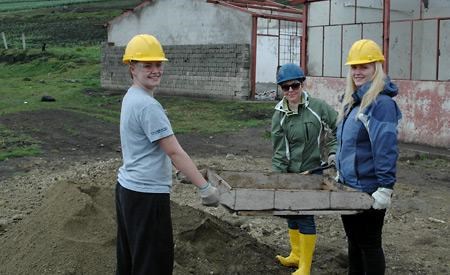Their feet were on the ground, but their heads were in the clouds.
Over spring break a group of 11 students, from grades 11 and 12, and two teachers from Brooks Secondary School, travelled to Ecuador for a service learning experience at over 10,000 feet above sea level.
They went as part of a group of more than 20 BC students, with others from Victoria and Whistler.
The group spent 10 days immersed in the culture and traditions of Ecuador, at the same time undertaking a building project to provide better access to education for young people in the community of Llullin.
The trip helped students to put their own struggles into perspective. “School for those kids there is a luxury,” said Taylor Bleaney, a Powell River participant who recently graduated Brooks and is now a first year student at Vancouver Island University. “It’s just something to get an education.”
Free the Children, an international charity started by Canadian brothers Craig and Marc Kielburger, has been working in Ecuador since 1999. The organization’s primary focus was to build schools, but since 2008 its work has expanded into helping communities develop sources of clean water and sanitation, health, alternative income and livelihood as well as agriculture and food security.
Chris Bratseth and colleague Kris Heuckroth, both School District 47 teachers, helped organize the trip for the students.
As Brooks’ Compassion Club’s teacher advisor, Bratseth has been a supporter of Free the Children and Me to We, the charity’s social enterprise arm, for more than a decade.
Heuckroth, an art teacher at Brooks, is no stranger to travelling with students, having supervised groups on four other international trips including Me to We in China last year.
Over approximately a year and a half, each student raised more than $4,000 to go on the trip.
Some students raised 100 per cent through fundraising and some paid for the trip through their part time jobs and with help from their parents and relatives, said Heuckroth. Brooks Parent Advisory Council chipped in $20 per student to help with travel in Canada.
The group spent its first few days in the Ecuadorian capital of Quito where they visited museums and took a walking tour through Quito’s historic churches and plazas.
Then it was on to Llullin, in Chimborazo province, where students and staff lived among the indigenous people of the area, and worked with the community to build a resource centre at their high school. A principle of Free the Children is that the students are giving a hand up and not a hand out. They reported they were treated the same as any member of the community working on the project.
Although the high school construction is a community project that has been worked on for a few years, student Graham Hanson and the others found themselves laying the resource centre’s foundation with adobe bricks they made and cement they mixed. There weren’t any construction workers or business people with blueprints, said Graham. “It wasn’t what I expected,” he said. “I thought we’d be going down there to work on something that was already under construction.”
The students took part in a short workshop which taught them about construction safety, and took classes in basic Spanish.
“We did whatever they wanted us to do,” said Bleaney, “but most of us had no experience in construction. It was physically exhausting work, but it was fun because we were all working together.”
Heather Rowbotham, one of the students and a marathon runner, said she was surprised how the altitude affected her. “I was out of breath climbing the two flights of stairs to my room,” she said.
Chimborazo province, in the rural Andes, is home to a large number of indigenous communities, who are challenged by the highest rates of poverty in the country. The communities have very limited access to education, water, economic opportunities, health care services and a nutritious food supply.
To help immerse them into the culture, the visiting students lived in the community and didn’t have access to their cell phones or cameras. In the evenings they would play games or cards or go for walks.
For Heuckroth there was a nostalgia in the students’ interactions with each other. “All of a sudden it was like going back a generation to a time when people didn’t have televisions or computers,” he said.
Students also visited an indigenous women’s group in the community, where they learned how micro-lending is helping women develop economic self-sufficiency. Women in the community are receiving loans as small as $100 to start up small businesses to support their families.
“It’s so incredible to learn about history, geography and social justice in those spaces,” said Bratseth, “to hear those women’s stories in [the] cooperatives and hear first hand how social change is happening from a first-person source.”
To further instill an understanding of the lives of local families, the students went to Guamote market where they were tasked with buying food on a typical family’s daily budget of approximately $1.25.
“As much as we gave to that community,” said Bratseth, “they gave us that and more back in teaching, connection and reframing our understanding of what education and what being a community member means.”



